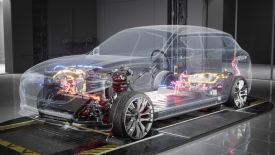Pressure Mapping for EV Design
Design differences and challenges for the next generation of EVs can be quite different than existing design for internal combustion vehicles. In addition to the core battery stack assembly and design, pressure mapping system analysis is key to many different aspects of electric vehicle design, as well as safety testing and quality assurance.

- Enhanced seat and seatbelt design - The evolving design of EVs and autonomous vehicles changes the dynamic relationship of seat back and cushion pressure.
- Tire design - Differences in torque and a host of other factors make tires designed for EVs very different than those for combustion engines.
- Impact testing and chassis design - Sensors testing impact underneath the car from debris can be an important consideration in battery placement and protection.
- Door design and door seal measurement - Door seal pressure design weaknesses impact noise, leaks, and aerodynamic efficiency.
Pressure mapping data can help you with everything from new designs needed for charging ports to re-engineering every element of EV and future vehicles. The data you collect during research and development, design, and testing will contribute to passenger safety, comfort, and vehicle efficiency.
Engineers all over the word are using I-Scan to gain insights into their battery design for automotive, consumer electronics, and more.
How can we help you?
We can help you find or customize a product for your application.



